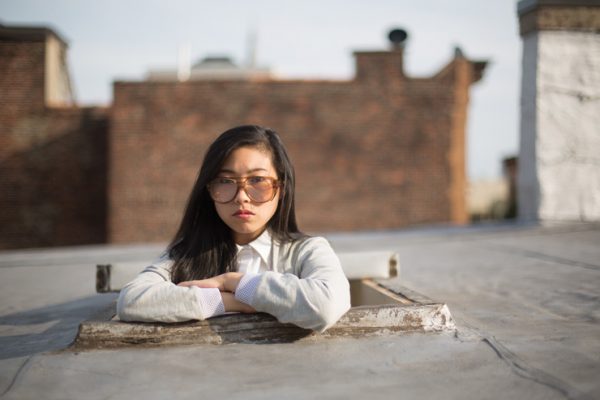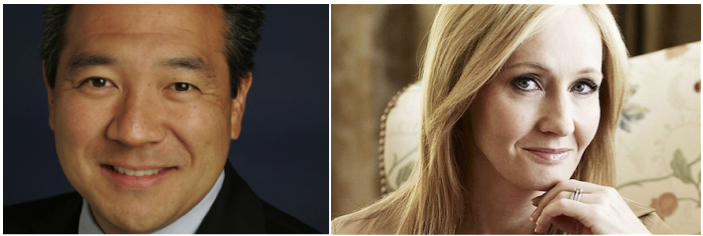Photo by Victor Chu
***
Back at the BUST show, it was time to perform, and Lum left her drink at the bar, barely sipped. Wild applause greeted her onstage. The crowd knew who she was. The beats to her songs, skeletal and synthy, boomed through the system. She rapped authoritatively, her voice dropping even deeper, much of the playful casualness of her videos gone as she assumed the role of rapper. She closed with “My Vag,” and the crowd was ready, some of them rapping along with her, most of them laughing.
My vag like a operatic ballad
Yo vag like Grandpa’s cabbage
And my vag effortless
Yo vag post ads on Craigslist
The thing about Lum’s lyrics is that there are enough internal rhymes, variations on structure, rhythm and cadence, to make it clear she is not just looking for words that rhyme.
“From whether it’s rhyme scheme to the beat choices to the pockets she chooses to rap in … she puts out like she hasn’t been rapping for too long, but she actually sounds good,” said Jonathan Park, aka Dumbfoundead, the prominent Korean American rapper and ambassador for Asian American hip-hop. “So that’s why I was like, ‘Oh sh-t, this girl’s serious.’”
A few weeks later, I met Lum at Enid’s, a restaurant in Greenpoint, Brooklyn, where, over a kale salad and a Miller High Life, she fielded my question about her “less vag, more art” comment.
“Did I say that? I need to stop putting it out there for people. It’s terrible,” she said. Whatever she had been feeling that day before the show had been dispelled by the crowd at the BUST show.
“I’d never gotten a reception like that before. They were literally laughing at every single line,” she said. “What I like is making people laugh. I feel like what I’m good at is adding comedy to rap music. … So I think BUST solidified that for me.”
A 19-year-old Lum originally wrote “My Vag” as a response to glam-rapper Mickey Avalon’s “My Dick,” and last year she sent the song to some friends of hers, who responded to it immediately. A low-budget video was shot featuring her roommate, her friends and wacky props.
At the time, Lum was one of those women she had mentioned, looking for things to click while working at her publicist job. She sent the “My Vag” video to The Hairpin, a women’s culture website that Lum said she’s “obsessed with.”
“That’s probably the smartest decision I made as a publicist. I was a sh-tty publicist,” she said. She knew the site’s sensibility, and they posted it.
“NYC Bitche$” upped the ante, she said. She didn’t feel much pressure at that point. The lyrics came quickly, though she admits she worked on the beat for some time. Or, as she put it, she “vomited” the lyrics, but it was a “kidney stone of a beat.” The song racked up similar numbers, and she started getting recognized on the street.
“At first, I was just in awe of what was happening to my life,” she said. “And then it went to, when you’re given something, you start to feel really protective over it, right? For some it might make them cocky, but for me it made me really stressed all the time. Paranoid. Just thinking about everyone I’ve met in my life, and all of my interactions. Weird self-judgment. But I feel like Awkwafina can’t be done without confidence. If I’m not confident, I can’t write music.”
The New York profile had come out in the interim, which only intensified the chatter around her. It may not have been a direct response, but in Lum’s follow-up, “Mayor Bloomberg (Giant Margaritas),” about the New York mayor’s proposed ban on oversized soft drinks, she included the following, non-soda related interlude:
The thing with me is I was born with a second vestigial gooch. To have that burden in a spiritual way, in a philosophical, in just a physiological, just walking around—They would call me ‘double gooch,’ ‘loads of gooch.’ Having a second vestigial gooch actually solidified my identity more as Asian, female, second gooch.
It’s post-feminist, post-racial, post-everything, a pitch-perfect response to any identity-related blabber she had been hearing. And, importantly, very much in keeping with the spirit of Awkwafina.
Jaeki Cho is working on a documentary about Asian American hip-hop. He said that, aside from Lum’s obvious talent, he believes part of her success stems from the audience she’s argeted. “She’s making really catchy songs [for] the core group of influencers,” he said. “I’m talking about the Gawker audience. I’m talking about the Gothamist audience. I’m talking about the tastemakers.”
Cho has a point. Four hundred thousand views is a lot, but it might not necessarily have been enough to make Lum famous had she not been in New York, rapped about local concerns (gentrifiers, Mayor Mike Bloomberg’s soda ban) in a way that jibes with a millennial sensibility, leading her work to be noticed by the subset of bloggers there who can drive the conversation for the rest of the country.
It was about that time that other Korean American rappers started noticing Lum’s work as well. Dumbfoundead felt he recognized a kindred spirit in Lum. “I think Awkwafina had a self-deprecating vibe to her, which I liked and I haven’t seen much in female rappers,” he said. “I just found her funny and not taking herself too seriously. Even though she wasn’t taking herself too seriously, she was good.”
He tweeted her (“I dig your sh-t”), and invited her to a show in New York. Through Park, she met other Korean American rappers, including Rekstizzy, aka David Lee (who occasionally contributes to these pages).
“A lot of Asian rappers and rappers in general are boring and generic as f-ck,” Lee said. “Nora is one of the more interesting rappers to come along, from the words she uses to rhyme with, the beat selection, the way she rides a beat, and definitely the content. A lot of people aren’t paying attention to all those things. They just see her glasses, hear the chorus and make their judgment, which is fine. … But, she’s the real deal. I am really excited to see where she takes her music, as a friend and fan.”
“The thing with that group is it’s really like family,” Lum said. She and Court Dunn, who directs her videos, “had one epic night drinking in K-town with them, and it feels like we’ve known them forever. … At that specific time, the New York magazine stuff went viral, and things were starting to get a little bit weird, and it felt really good to have, like, a sense of solidarity.” Lee and Park had cameos in Lum’s “Mayor Bloomberg (Giant Margaritas)” video, pointing toward the possibility of further collaboration.
***
Lum has been able to capture segments of the feminist-minded and Asian American audience, and her new album is mostly done as of this writing.
“I don’t want to spend the rest of my career chasing ‘My Vag,’” Lum said. People have been giving her advice about what kind of move she should make next, whose career she should model hers on, but none of it feels right. “That’s not me. I feel like I’d be selling out, I wouldn’t be doing what I’m good at.”
She feels she’s grown a great deal as a producer, drawing from influences like noted sonic omnivores Major Lazer and Hudson Mohawke. Her tongue-in-cheek lyrical approach will remain much the same, she said. The video for the first song will be released soon, and whether it’s “Awkwafina does it again,” or just the ominous silence of mouse buttons not being clicked, remains to be seen.
“It’s a tough journey,” said Park, who himself has transitioned from being known primarily for his battle rap punchlines to being able to support himself through his music, comedic and serious. “I think with her, she definitely, musically and art direction-wise, she’s already on the right track.” And what she’s shown herself to be good at is making funny rap songs over her own beats, accompanied by funny videos, distributed online.
It’s a cliché to talk about how much easier it is now to make and distribute art online, without the interference of record labels, A&R or any of the other non-music-related aspects of the music biz. But it might have been harder to predict that it would have allowed so many different kinds of people to start rapping. The allowed multiplicity inherent in most genres of music took generations to build; jazz or the blues or rock or any other genre of American music had strict racial rules about who is authentic and who is not. Strict boundaries in hip-hop of insiders and outsiders, authenticity and artifice, are falling away with the inevitable cultural drift inherent in a heterogeneous society.
None of this means that there will be no more conversations about who is allowed to rap. But ultimately, people who don’t “look” like rappers are rapping. And even if Lum struggles to replicate the success of “My Vag” and “NYC Bitche$,” by being herself, she’s already done the work of stretching the boundaries just a bit wider. It’s the kind of thing that can even make the inevitable on-street encounter seem somehow bigger, indicative of a shift in the culture. As we packed up the car after the photo shoot, a youngish white man approached me.
“Hey, is that Awkwafina?”
“Huh?”
“Is that Awkwafina?”
I said yes. He was Conor Maher, aka DJ Bugbear, who spins at longtime Lower East Side fixture Pianos. He said he played “My Vag” all the time.
“Dude, the kids go nuts,” said Maher. “Bonkers.”
This article was published in the September 2013 issue of KoreAm. Subscribe today! To purchase a single issue copy of the September issue, click the “Buy Now” button below. (U.S. customers only. Expect delivery in 5-7 business days).








